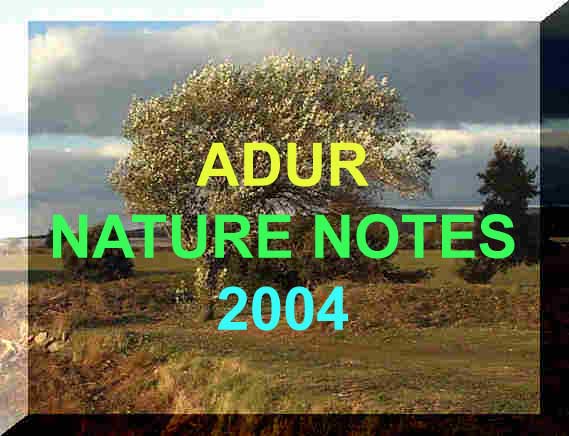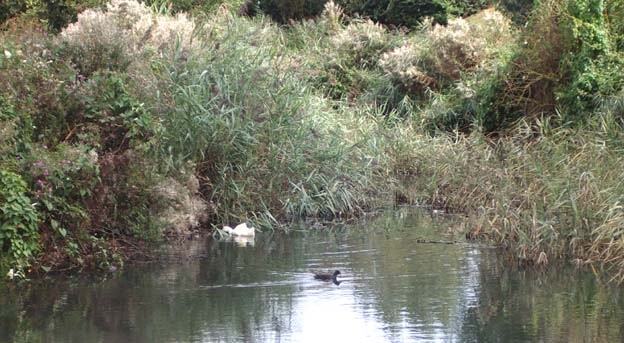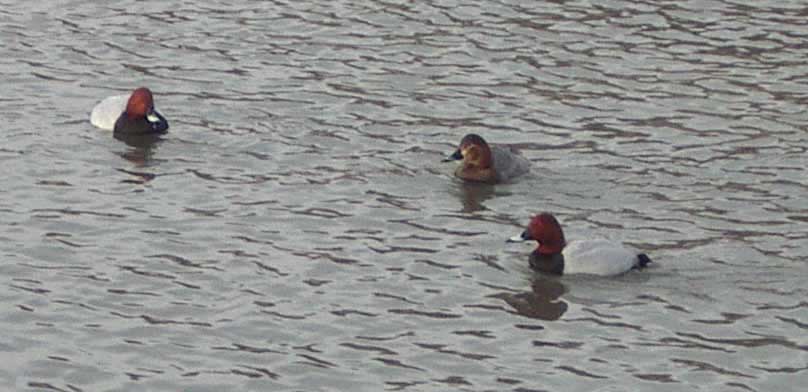 |
|
|
 |
 |
|
|
| Coastal Fringe |
| Chalk Downs |
| Intertidal (Seashore) |
| River Adur Estuary |
| River Adur Flood Plain |
| Sea (off Sussex) |
| Town & Gardens |
| Widewater Lagoon |
 |
| Saline Lagoon Links |
|
|
Brooklands
Boating Lake
formerly
the Brooks
Link to the Reports for 20056 April 2005
Conspicuously trotting over the short mown golf course green at Brooklands (east Worthing) the Great Spotted Cuckoo, Clamator glandarius, seemed unaware of its audience of birdwatchers. Under an overcast sky with a Strong Breeze (Force 6) blowing off the sea from the south-east, the cuckoo could be seen clearly out in the open where it seemed to be pecking at the ground (more like a Pied Wagtail than a Starling) for food.
Image GalleryThe Great Spotted Cuckoo spends the winter in Africa and flies north to southern Europe (including Turkey and Spain) to find a bird's (usually a corvids, especially Magpies') nest to lay a single clandestine egg for the surrogate parent bird to incubate and feed. It is a rare vagrant to southern England with only 39 records in Britain and Ireland up to the end of 1995. One of those was at Shoreham Airport before in 1990.
23 March 2005
There was just one Pochard seen amongst the usual Mallards and Coots.
9 February 2005
The twenty or so Pochards were tucking their beaks into their body. There were as many and probably more Coots on the lake, plus the occasional Moorhen.12 January 2005
There were two Dunnocks amongst the reeds at the edge of the lake and Pochards amongst the Coots and gulls.
13 December 2004
Four Tufted Duck are seen on Brooklands Boating Lake with twenty Pochards. Tufted Ducks are carnivorous, feeding on insects and small invertebrates, whereas Pochards are vegetarian.Report by Paul James on Sussex Ornithological Society News
1 December 2004
On Brooklands Boating Lake there were half a dozen or so Pochards, and at the southern end there was a congregation of about thirty Coots and a dozen or so Moorhens. It was here that I spotted a colourful yellow Grey Wagtail on the sluice gates.29 October 2004
I visited Brooklands Lagoon, Worthing this afternoon. I was busy watching a winter passage Little Gull, when five more tumbled out of the sky settled on the lake and started to actively feed. They were all adults. Also Firecrest, Kingfisher and Grey Wagtail.Report by Bernie Forbes on Sussex Ornithological Society News8 October 2004
A few of the more interesting birds had been reported from Brooklands recently, but I expect this from from the early risers, as in the mid-afternoon, there were just 30+ of the usual Coots or a fully flooded lake and a few Moorhens.28 July 2004
The first Emperor Dragonfly of 2004 was spotted majestically flying up and the down the Teville Stream that feeds into Brooklands Boating Lake over the reed-bordered stream open to the public. It had a a very bright pale blue abdomen and looked fresh in the sunshine.The boating lake was noted for the return of the commoner birds with about 30 Coots and a handful of Moorhens as well. At the southern end in a shallow area near the weir, small shoals of Ten-spined Sticklebacks and freshwater water beetles including the Water Boatmen were noted. A Common Darter Dragonfly flew over the lake.
Adur Damselflies and Dragonflies30 June 2004
Brooklands Boating Lake in flood but there was a paucity of birds, just a pair of Mallards were seen in the main area of the lake.16 June 2004
Below the weir the main part of Brooklands boating lake looked slightly a milky white colour. I did not see any of the usual Moorhens and Coots and there were just a handful of gulls on the surface of the water in the centre, which did not seem to be discoloured.

27 May 2004
The Moorhen chicks followed the white bread that was fed them accompanied by a Coot and no sign of the parent Moorhens although a Mallard was also at the feeding station on the main part of the lake but just south of the weir and bridge, by the miniature railway station.
(People are discouraged from feeding the water birds by notices.)7 April 2004
There were relatively few birds on the lake, which was now back into full flood after some maintenance work. Nine cute Mallard chicks swam after their parents, the drake and the hen Mallard.

11 February 2004
Brooklands Boating Lake has been drained again and there is lots of mud exposed. The freshwater stream that feeds the brackish water lake was pouring over the weir in a continuous flow. In living memory the whole area was a marsh with allotments called the Brooks. It has been drained and landscaped to be enjoyed by the public, but it may have been a bit too sanitised to appeal to some shyer species of birds.19 November 2003
Brooklands Boating Lake was visited for the first time since the reports of it being drained of water for repairs. This has left patches of black smelly mud, but there is still extensive shallow water where the large population of Coots, Mallards, Moorhens and Black-headed Gulls can rest, with at least one Mute Swan. Over the grass there were a few Crows, a handful of Herring Gulls and a visiting male Kestrel. (Some of the Mute Swans died and others were removed by WADARS after the mysterious deaths earlier this year.)
Birds around a rock with
the mystery organism growing on itA dumped motorcycle covered
in a strange wormA strange worm was noticed for the first time growing on the stems of reeds and on solid objects in Brooklands Boating Lake. It has not been seen in Brooklands since the lake was created. It was first spotted this summer from the seaward southern end and spread all over the lake but not to the full freshwater reaches called the Teville Stream. This is the feeder stream from the north.
Report with information from Mrs HawkinsMystery from Brooklands 2003
The small holes which look like the skeleton of a microscopic animal have an external diameter of up to 1 mm and an internal diameter of up to 0.8 mm.
Each tube is from between about 10 mm to 25 mm in length.
At the time of writing I have not identified the animal which could be a worm or a bryozoan? The reasonable speculation was that it has been able to become established this year because of increased salinity in the low brackish water lagoon, because of the profound lack of rainfall this year. There are sluice gates separating the lake from the sea, and the juvenile stages may have arrived with a seawater intake.
The worm tubes are omnipresent on all the hard substrates and reed stems in brackish lake below the weir. In the freshwater reaches above the weir, the worm tubes are present but only in small amounts. (Investigation of 28 November 2003). It does seem that the weir only functions when the water level is reduced and for most of this summer the lagoon water level is above the level of the weir.
The mystery organisms are the empty tubes of the serpullid worm, Ficopomatus enigmaticus.
R.S.K. Barnes in "The Brackish-water fauna of Northwestern Europe" writes about this worm:
"A southern species often termed Mercierella, that extends northwards to the southern North Sea. It will construct its c. 1 mm diameter, up to 30 mm long tubes on most substrata, natural and artificial, including the stems of Common Reed, Phragmites, and is particularly characteristic of harbours, docks, artificial lagoons and power-station outfalls with salinities of from 35 down to 10 ppt (and exceptionally, in fresh water); it has also been recorded from several natural lagoons. The tubes, which possess circular, shelf-life platforms near their mouths, are often aggregated into large colonies."Information and first ID by Richard Lord (Guernsey)
via the Marine Wildlife of the North-east Atlantic Ocean Group
Our Dutch name translates into: "trumpet-calcareous-tube-worm" since the tube often looks as a series of trumpets. This worm disappears after cold winters, demonstrating its subtropical origin.Corrected and additional information by Godfried Van Moorsel (EcoSub)JNCC Information Page on Ficopomatus enigmaticus
12 November 2003
Brooklands Boating Lake (east Worthing on the Lancing border) has been partially drained of water so that repairs to the wooden supports of the embankment can be carried out.Several Hearsay Reports including on the Sussex Birds Yahoo GroupA Little Egret visited the lake for the first time, perhaps appreciating the lowered water levels.Report by Paul Robards on the Sussex Birds Yahoo GroupThe is also an authentic report of a pair of Canadian Geese paying a brief visit to the muddy lake.
and other reports as well
Previous Bird Report
22 October 2003
Summer seems to be over with hailstones, a chilly south-easterly breeze (Force 4) and a perpetually grey overcast sky with rain showers.On Brooklands Boating Lake (east Worthing on the Lancing border), there were about 80 Coots, over a dozen Mallard, two Mute Swans, one Pochard and one Moorhen. On the beach sand a score or more of Black-backed Gulls rested and there were at least three Redshanks feeding in the Widewater shallows at the eastern end of the lagoon.
20 October 2003
The chill northerly breeze felt like winter for the first time since February, and the temperature was only 8.5 ºC at 5:00 pm.
On and around Brooklands Boating Lake (east Worthing on the Lancing border), there were two Kingfishers, two Grey Wagtails and four Goldcrest.
27 August 2003
Brooklands Boating Lake (see the entry below) could not be hypertrophic (overnutrified, cf. eutrophic) because in the upper stream reaches a shoal of about 30 Rudd could be seen in the clear slightly cloudy water, with broken bits of algae, but no aquatic plants, although there was some marginal waterside vegetation. These silvery fish were attractive with their bright red fins.

The Teville Stream feeding Brooklands
There were the usual plentiful 50+ Coots on the main body of the lake, but I only spotted one Moorhen in the upper reaches.
19 August 2003
There were over a hundred birds on Brooklands Boating Lake (see the entry below) and the Coots, Mallards and Black-headed Gulls all appeared to be in fine fettle. A dozen Martins were swooping around the island. These martins appeared very brown and they were probably Sand Martins? (They were too far away to be absolutely sure.)
14 August 2003
The Shoreham Herald reports that Brooklands Boating Lake is again closed because of the mysterious deaths of both resident and visiting birds including six Mute Swan cygnets, two Coots, nine ducks and one gull. The cause is till unknown. A toxic blue-green algae and botulism have been suspected as well as polluted silt in the lagoon. The smelly problem occurs in late summer when the temperatures are at their warmest. The water in Brooklands is mostly fresh stream-fed water, and is shallow without any appreciable water plants.
Blue-Green Algae Toxicity in Waterfowl
The blue-green algal toxins can be harmful to humans and pets, and can be transmitted by pet dogs. Death in waterfowl can be rapid with the species of algae that produce neurotoxins (including anatoxins). There are various different blooms of algae, all of which are encouraged by eutrophic water conditions.
Botulism has also be found to be the cause of fatal disease in ducks in British town parks.
Archives: Sewage Pollution (Brooklands)
Archives: Pollution Scare (Brooklands)
12 February 2003
On a misty drizzly day the Ruddy Shelduck sheltered in the lee of the island on Brookland's Boating Lake, with over fifty Coots, a couple of Moorhens and a small flock of about a dozen Pochards which could be seen reasonably close up (with 10 x 25 binoculars) with their attractive maroon head (male only).
The very few reports from Brooklands prior to year 2003 have not been included on these pages yet.
Script
and page design by © Andy
Horton 2003 - 2004
Local Wildlife Links (SE England)Adur Biodiversity Exhibition 2001
Adur & the Downs: Protected Sites
Adur Valley Nature Notes 2003
Adur Valley Nature Notes 2004
Adur Valley Wildlife
Adur Wildlife Gallery
Birds of Sea & Seashore (BMLSS)
Carmarthen Bay Saltmarsh SAC
Dungeness, Kent, England
Friends of Widewater Lagoon
Orford Ness: Coastal Ecology of a Shingle Bank (excellent references)
Ralph Hollins Nature Pages (Chichester Harbour area)
Rockpooling Page
RSPB Saline Lagoons
Rye Harbour Nature Reserve
Seashore Page
Shingle Coast (Coastal Fringe of Shoreham Beach)Shoreham-by-Sea Wildlife Page
Sussex Wildlife Web Sites
Verdant Mud (Glasswort)
Widewater Lagoon Slide Show (by Ray Hamblett)
|
|
|
|
|





